11. PowerPoint Presentation for Accessibility
Ben Tait and Pratik Bhawar
Reviewing your Existing PowerPoint for Accessibility
One of the most common issues for accessibility within PowerPoint is the temptation to over-design our slides. Simplicity is key. Not only do unnecessary imagery, transitions and animations create more work for us (because we need to mitigate their impact on accessible technologies), they can also create visual distraction and cognitive overload. It can be satisfying to have a beautifully designed set of slides which inspire the learner’s confidence, but this should not be done in a way that creates barriers.
Simple, direct and consistent communication will support the wider range of learners, whilst also keeping things simple and time-efficient for you.
Also, while our focus here is on the creation of the resource itself, do remember to always use any amplification technology available within your teaching space, even if it feels unnecessary to you. Those using audio-enhancement technology such as hearing aids often rely upon such systems, even within small spaces and with small groups.
Accessibility Checker
Utilize this Accessibility Checklist to ensure you’ve covered the essentials of accessibility for any new or existing document. Each item on the checklist is linked to the corresponding chapter/section, providing practical tips for further understanding and editing your documents.
- My presentation has a title which is meaningful to the students/users?
- If not, please follow this link for more information on: Saving and Naming the file
- My presentation uses correct reading order for various sections information in the slides?
- If not, please follow this link for more information on: Setting up your slides for accessibility
- My presentation uses standard and easily readable fonts?
- If not, please follow this link for more information on: Formatting text for accessibility
- My presentation has sufficient colour contrast between the text and the background?
- If not, please follow this link for more information on: Enhancing Readability with Colour Contrast
- My presentation uses tables which are simple and have definite header rows?
- If not, please follow this link for more information on: Using Tables within Powerpoint
- My presentation uses PowerPoint’s built-in functions for creating lists and columns?
- If not, please follow this link for more information on: Creating a List and Creating Columns
- My presentation uses hyperlinks with concise and meaningful names?
- If not, please follow this link for more information on: Using Accessible Hyperlinks
- My presentation has alternative text for images and other visual objects?
- If not, please follow this link for more information on: Create Accessible Images and Objects
- My presentation has supplementary descriptions for embedded audio/video files?
- If not, please follow this link for more information on: Create Transcripts, Captions and Audio Descriptions
- My presentation passes the accessibility checker?
- If not, please refer to the information in this chapter below.
Enable the Speak Feature
Enabling the Speak feature in Microsoft PowerPoint serves as a valuable preparatory step, especially when you are going to review your existing presentations with the Accessibility Checker. Speak feature, can be used to audibly articulate the text content of your presentation to verify if the texts are placed in the appropriate reading order. This preview also assists you in evaluating the effectiveness of any adjustments made based on recommendations of the Accessibility Checker.
How to do it:
- Open the PowerPoint desktop application.
- Navigate to the “File” tab, scroll down, and select “Options.”
- In PowerPoint Options, click on “Quick Access Toolbar.”

- Choose the “Commands Not in the Ribbon” option from the “Choose commands from” dropdown menu.
- Scroll down the commands list alphabetically, find “Speak,” and click on it.
- Add the Speak feature to the “Customize Quick Access Toolbar” pane by clicking on “Add.”
- Scroll down further, then click “OK” to confirm the changes.

With Speak now added to your Quick Access Toolbar, you can easily activate it for any PowerPoint document. Note that, by default, Speak is enabled for all PowerPoint documents. If the Speak button appears inactive, simply select the text you wish to be read aloud and it will be activated.
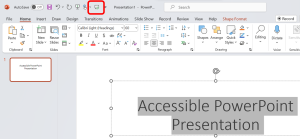
Running the Accessibility Checker
When you already have a bank of resources created and want to begin by ensuring that those resources are optimized for accessibility, the first source of guidance is the Accessibility Checker. It serves as a quick preliminary check, swiftly scanning your content to pinpoint potential accessibility issues. This initial step offers an easy and insightful analysis, guiding you toward making informed edits and improving the overall electronic accessibility of your resources.
How to do it:
- Ensure your file is saved in the “.pptx” format. Older formats may not be compatible with the checker.
- Navigate to the “File” menu. Under the “Info” section in the left window pane, select “Check for Issues” and then choose “Check Accessibility.”
- A task pane will open, presenting the inspection results.
- Select a specific issue to view additional information and follow the provided steps to rectify or revise the content.

The Accessibility Checker categorizes necessary changes into three primary classifications: Errors, and Warnings. Errors denote content that renders a file challenging or impossible for individuals with disabilities to comprehend, requiring immediate attention for rectification. On the other hand, Warnings flag elements that, while not universally obstructive, can still impede the understanding of individuals with disabilities in specific cases.
Common Accessibility Errors in PowerPoint
Missing Object Description
When an object lacks a descriptive alternative, it becomes a hurdle for users relying on assistive technologies. Upon encountering an object without alternative text, the checker provides a clear directive to either “Add a description” or “Mark as Decorative“.
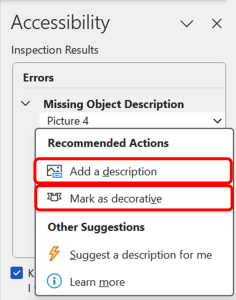
Consider the following questions for the next steps:
1.Does your graphic serve more of a decorative purpose? In other words, is it primarily a design element that does not convey content? If so, you should:
- avoid unnecessary text descriptions by clicking on “Mark as Decorative” option.
2.Does your graphic serve a functional purpose? In other words, is it conveying non-text content? If so, you should:
- provide a text alternative that serves the equivalent purpose of the non-text material by clicking on the “Add a description” option.
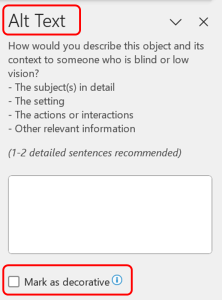
For detailed guidance on how to capture the meaning in Alt Text, see our dedicated section here: Chapter: Create Accessible Images and Other Visual objects
Follow this link for video instructions on: Editing Images, Charts and other objects for accessibility in PowerPoint (external site – opens in new tab)
Missing Slide Title
One common accessibility concern in PowerPoint is the absence of slide titles, hindering proper navigation and comprehension for individuals relying on screen readers. To rectify this, ensure each slide has a clear and descriptive title.
Selecting the “Edit Slide Title” option in the accessibility checker will take you to the slide title placeholder. Enter a concise yet informative title that encapsulates the slide’s content, and follow suite for all the slides with missing titles.
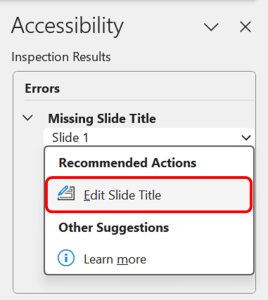
Follow this link for video instructions on: Using Titles to make PowerPoint Slides Accessible (external site – opens in new tab)
Missing Table Header
For tables intended to convey data, it’s essential to designate header rows explicitly. When the Accessibility Checker identifies a table without a specified header row, it signals a potential challenge for users relying on screen readers. To address this error:
- Select the “Insert Header Row” to add a new row designated as a header for the Table
- Or else, select the “Use first row as header” to automatically designate the first row of your table as its Header

For detailed guidance on how to create an accessible table from scratch, see our dedicated section here: Chapter: Create Accessible Tables
Follow this link for video instructions on: Creating accessible tables in PowerPoint (external site – opens in new tab)
Accessibility Warnings in PowerPoint
Use of Spilt or Merged Cells
The “Merged or Split Cells” warning serves as a gentle reminder to evaluate the structure of your tables for optimal accessibility. While merged or split cells might not always pose a significant barrier, they can impact the coherent interpretation of the data in your tables by screen readers.
If cells have been merged within a table, consider whether this merging is essential for the visual presentation. If not, unmerge the cells by selecting “Split cells” option and vice-versa if there are split cells in your table.
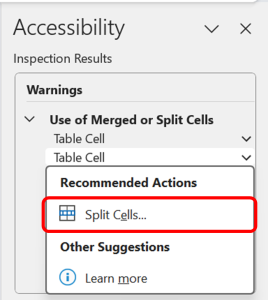
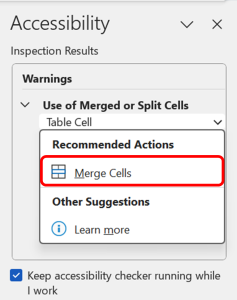
For more information, and for guidance on how to create complicated tables, see this guidance from the Web Accessibility Initiative: link to W.A.I guidance (opens in new tab)
Hard-to-Read Text Contrast
The “Hard to Read Text Contrast” warning in highlights instances where text might pose readability challenges due to insufficient contrast with the background. Addressing this warning is crucial for ensuring that all readers, including those with visual impairments, can comfortably engage with your document. To address this warning:
Change Font Color: If the warning pertains to specific text elements, such as font or characters, a simple solution is to modify the font color. Opt for high-contrast combinations to ensure readability for all readers.
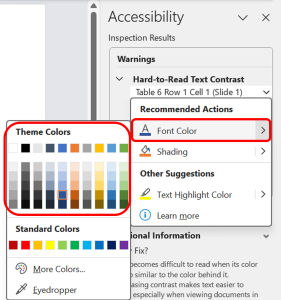
If the warning specifically relates to table content, consider adjusting the shading settings. Select the option for “Shading” to view and apply the most appropriate Colour for the table.

Check Reading order
When PowerPoint’s Accessibility Checker highlights a reading order warning, it’s prompting you to ensure the logical sequence of objects on a slide for improved accessibility. To address this warning:
- Select the option to “Verify Object Order.”
- This action opens the Reading Order pane, allowing you to review and adjust the sequence of objects.
- Simply drag and drop the elements within the pane to align them with the intended reading order.
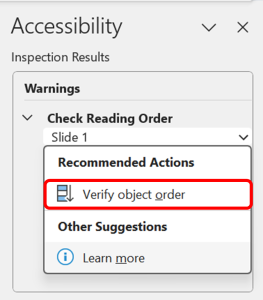
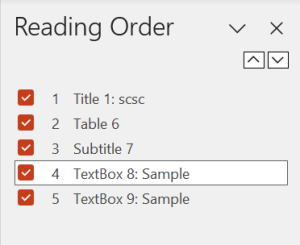
For detailed guidance on creating a logical reading order, see our dedicated section here: Using the Slide Master and Selection pane to check the reading order
Missing Audio or Video Subtitles
If the Accessibility checker detects that any media files included in the presentation are missing captions, it highlights a warning regarding missing audio or video subtitles. To address this, the tool suggests adding captions directly from your device. It’s important to note that the checker does not generate captions; you must have them ready for incorporation.
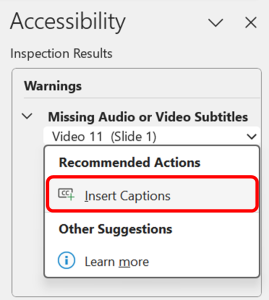
For a more detailed guide on creating accessible captions, transcripts, and audio descriptions, refer to the dedicated section here: Chapter: Create Transcripts, Captions and Audio Descriptions
Please don’t hesitate to contact us with suggestions and updates using this: email link for updates(opens in external site/application)
Reference:


Feedback/Errata